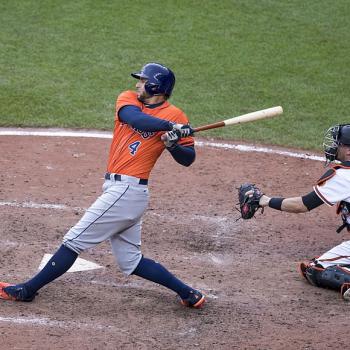When you live in a town with a team that is passing rapidly through mediocrity on its way to contention — the Nats have an amazing crop of upcoming young players — you go for the moments.
I go to see Ryan Zimmerman charge a slowly hit grounder down the third-base line. This happens roughly once a game. Zim comes flying in, picks up the ball barehanded and throws it across his body to first base, perpendicular to the direction he’s running.
Except that this cannot be done. You could never get enough (velocity) on the throw to get the out at first. So Zimmerman dives forward, leaving his feet and hovering there for an instant, his body parallel to the ground in order to get more arm extension and thus more on the throw, which by now is nearly underhanded, his fingers almost scraping the ground. Batter out.
Try this yourself. Aim for a barn door. You will miss. And also dislocate your shoulder.
Another attraction is rookie second baseman Danny Espinosa. He has what in baseball parlance is known as range. A hard shot is hit to the hole between first and second, and Espy ranges to his left to snag it. Three weeks ago, one shot was hit so hard and so deep that he had to dive onto the outfield grass to reach it, sliding on his side in the general direction of the right-field foul pole.
Nice grab, but unless you can get the ball to first, it’s just for show. Espy starts to get up. But there is no time for standing. So, from his knees, while still sliding on the grass out toward the stands, he forces himself into a counterclockwise 180-degree spin to throw back toward first base — except that he actually begins his throw mid-turn, while facing the outfield, thereby gaining velocity from the centrifugal force (and probably the rotation of the Earth, although this remains unverified). It’s like throwing on your knees from a spinning merry-go-round that is itself moving laterally in a landslide. Try that.
Batter out.
The piece de resistance, however, is what center fielder Rick Ankiel pulled off last Sunday. It’s the bottom of the ninth, one out. The Reds have just tied the game with a solo homer. They need one more run to win. Batter crushes the ball to right-center field. If it clears the wall, game over.
But it doesn’t. It bounces off the wall, eluding our right fielder. Ankiel, who had dashed over from center, charges after the ball, picks it up barehanded and, in full running stride, fires it to third, to which the batter is headed and from which he is very likely to later score and win the game (there being only one out).
Now, when mortals throw a ball, they give it arc to gain distance. That’s how artillery works. Ankiel is better than artillery. He releases the ball at the top of his throwing motion, the ball rocketing out as if tracing a clothesline. It bounces five feet from third base, perfectly on line, arriving a millisecond before the batter and maybe 20 inches above the bag.
Quick tag. Batter out. Game saved. (Blown five innings later. But remember, it’s the Nats.) Said Nats broadcaster and former major leaguer F.P. Santangelo: “That might be the best throw I’ve ever seen.”
via The best show in town – The Washington Post.
If you don’t believe that first example, here is a picture of Ryan Zimmerman throwing:














